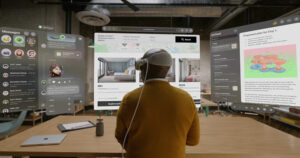
Part of the fun after CES is to weave the various announcements and showcases together to get a view of a future that might result from a blend of them. The goal, if you can call it that, is like imagining the cars of the 1950s and ’60s, but from a 1920s perspective with then-recent developments such as compact hydraulic pumps and air conditioners in the forefront.
Even if there won’t be much in the way of tailfins, this year’s CES saw a number of big announcements that could lead to a much more amazing future.
AMD + Nvidia = Augmented Reality Home
Nvidia made two announcements that set a stage for bigger things: its GeForce Grid Server and the Shield game system. At the same time, AMD demonstrated positional audio in a cabin that replaced windows with TVs. Now Imagine…
The reality you see from your windows, either in your home or while driving, is streamed. On a rainy day, you can see sun or sunny-day rain; you can appear to be living in a forest or driving through a scene from The Hobbit. (Granted, I’d likely feel better if we added Google or Audi’s self-driving capability to this model.) Even when you are away from your home or vehicle, you have a handheld system that can interact with this virtual world.
How does this vision follow from the AMD and Nvidia announcements? To begin with, the Nvidia servers and game system would provide the visual content, blending the real things you have to avoid with their fanciful counterparts so you aren’t walking or driving over people or obstacles. Basically, the role of the streaming servers would be to overlay what the inputs — the camera on the Shield system, cameras on your house and car, your office and so on — are seeing with reality.
Meanwhile, the AMD technology would be blending the visual image and sound to make everything seem much more real. Add a head mounted display, headphones, and something that could provide smells, and you could find that living in a virtual world could be a ton of fun.
AR Drone + Ford Apps
Back in the 1960s, the hero of The Green Hornet TV series had a car that would launch a personal drone, which offered remote viewing capabilities on the car’s built-in TV screen. This was a little much by the standards of the day; even the “infragreen” headlights had more plausibility than the drone. Like so many gadgets of that era, the plot device is now reality; the folks over at AR Drone unveiled the latest version of their tablet/smartphone controlled four-rotor drone with Ford-showcased app technology.
Now, imagine you are stuck in traffic and you want to know what the problem is and whether you can do anything to get back on your way. You launch your drone from a hidden compartment in your car, and remotely guide it using your car’s screen to the site of the accident. What your drone sees gives you insight into whether you should be easing off the freeway, staying and waiting, or giving up on your car and running for the hills (in case the traffic jam is the result of a zombie invasion).
Alternatively, nervous fathers could go to a drive-in and make sure that their little darlings are in trustworthy hands. Suddenly, adding a dart or squirt gun feature to the drone seems like a good idea.
Smart-Aleck Appliances
The Chinese and Korean vendors were aggressively showing off smart appliances or appliances with tablets built into them. What if you wrapped these with an AI back end and gave them voices with attitude so they could be critical of your family when you weren’t around? Whether it’s nagging family members about their waistlines and the effect of that next beer, or their fashion choices, or the need to follow through on chores, the possibilities for passive-aggressive hijinks are endless.
You can relax and be the nice parent for once and let the appliances do all the kvetching for you. Granted, this stuff could do the same to you, which brings up the matter of admin privileges. I suggest the spouse who pays for the stuff should be the one that can set and target the nag feature. You can picture future spouses and domestic partners arguing who will buy the next appliance: “No dear, I’ll buy this one — really, it’s my turn.” (Damn it, I can’t TAKE the nagging anymore — seriously, I need to buy it this time!)
Wrapping Up: An Even More Connected Future
CES 2013 presented the possibility of an even more connected future, when you will be increasingly unable to separate the real from the virtual, when robots and drones become an ever bigger part of your daily life, and when your appliances can become even more annoying. (Maybe we want to pass on this last.)
In any case, I can hardly wait until next year, when this stuff will get even more invasive. (Whoopee?)
Product of the Week: FitBit

AMD CEO Rory Reed turned me on to FitBit at the show, and both my wife and I are now hooked on it. It is a wearbale device that measures how much activity you do during the day, the quality of your sleep, and in competitive mode — say, with your spouse — how well each of you are keeping to your weight loss plans. (At it happens, my wife is kicking my butt.)
FitBit also offers a WiFi-connected scale, allowing it to track weight loss (assuming you start losing weight). The sleep monitoring is interesting as it tracks how often and when you are awakened. This could be a good way to show your snoring spouse the need to address the problem. (Fortunately, my wife hasn’t activated this feature on her FitBit … yet.)

The FitBit device — in our case, the FitBit One — connects to a PC, and through it to the Web, so that it can compile your activity in terms of steps taken and stairs climbed, and tally this activity against goals you have set for your exercise and diet program.
I’m still recovering from a leg injury I got a few weeks ago, so I’m clearly not putting in the time I should; nevertheless, it is getting me off my butt more than would otherwise be the case.
FitBit is a powerful piece of personal health technology and rather useful, making it my product of the week. Thanks to AMD’s Rory Reed for this great idea! Granted, if the scale ever says “Ouch, I’m not rated for that, get that truck off me,” the whole thing is going out the window.























































